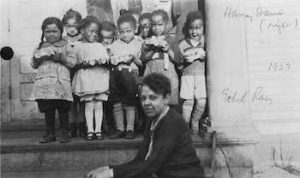
Ethel Ray Nance at the Phyllis Wheatly House, 1927
*Ethel Ray Nance was born on this date in 1899. She was a Black writer, activist, and administrator.
Ethel Ray was born in Duluth, Minnesota. She was the youngest of four children born to William H. Ray, a Black man from North Carolina and a white-American Swedish mother. She was raised in Iowa by a German family and Inga Nordquist Ray, a Swedish immigrant.
At the time of her birth, Duluth had a tiny African American population of about 200. Speaking to an interviewer years later, Ethel recalled being lonely as a child. She and her family faced racism from neighbors and community members. Her father was a significant influence in her life and often read to her and her siblings about African American struggles and the need to stand up to racism. During high school, Ethel was trained in stenography.
In 1919, she began working as a stenographer for the Minnesota Forest Fires Relief Commission, helping the 50,000 victims of the 1918 Cloquet, Duluth, and Moose Lake, Minnesota Fires. In June 1920, the Duluth Lynching took place. The men were lynched four blocks from Ethel’s childhood home. The lynching prompted Ethel’s father to organize a branch of the NAACP for the city of Duluth. A year later, W. E. B. Du Bois came to speak at a Duluth NAACP meeting; young Ethel was asked to accompany him from Minneapolis to Duluth. The meeting helped to form a life-long friendship between the two.
By 1923, her connections with the Minnesota Forest Fires Relief Commission led the Minnesota Legislature to hire her as a stenographer. Her position in the legislature, the first held by an African American, made national headlines and brought her to the attention of the Kansas City Urban League. While working for the Kansas City Urban League in 1924, Ethel met Charles S. Johnson, director of research of the New York Urban League and editor of Opportunity, the League’s magazine. He offered her a position in New York as his secretary, writer, researcher, and editor for Opportunity. Ray accepted and moved to New York, where her apartment became a gathering place for young writers and artists during the Harlem Renaissance.
Four years later, the need to care for her sick mother brought Ray back to Minnesota. After a short time in Duluth, she relocated to Minneapolis and took on the position of associate head resident at the Phyllis Wheatley House. In 1928, the Minneapolis Police Department formed the first women’s bureau and hired her as Minnesota's first African American policewoman. She continued to work until 1931, when acute arthritis forced her to retire. Ray married her first husband, LeRoy A. H. Williams, in 1929. They had two sons: Thatcher, born in January 1933, and Glenn Ray in July 1934. They moved throughout the country, where she worked various secretary jobs. By 1943, she had separated from her first husband and lived in Seattle. In February 1944, she married Clarence A. Nance; her two sons took his last name.
In 1945, Ethel Ray Nance and her family relocated to San Francisco, where she became a secretary for Du Bois. He was a consultant to the American delegation at the founding of the United Nations. After a short stint working in New York, she returned to San Francisco and worked for the NAACP for ten years. She went on to work for the San Francisco African American Historical and Cultural Society, where she wrote about her association with Du Bois. In 1978, she became the oldest to receive a Bachelor’s degree from the University of San Francisco. Ethel Ray Nance died in San Francisco on July 11, 1992. She was ninety-three years old.